tow CHEVROLET CORVETTE 1994 4.G Owners Manual
[x] Cancel search | Manufacturer: CHEVROLET, Model Year: 1994, Model line: CORVETTE, Model: CHEVROLET CORVETTE 1994 4.GPages: 274, PDF Size: 15.61 MB
Page 13 of 274
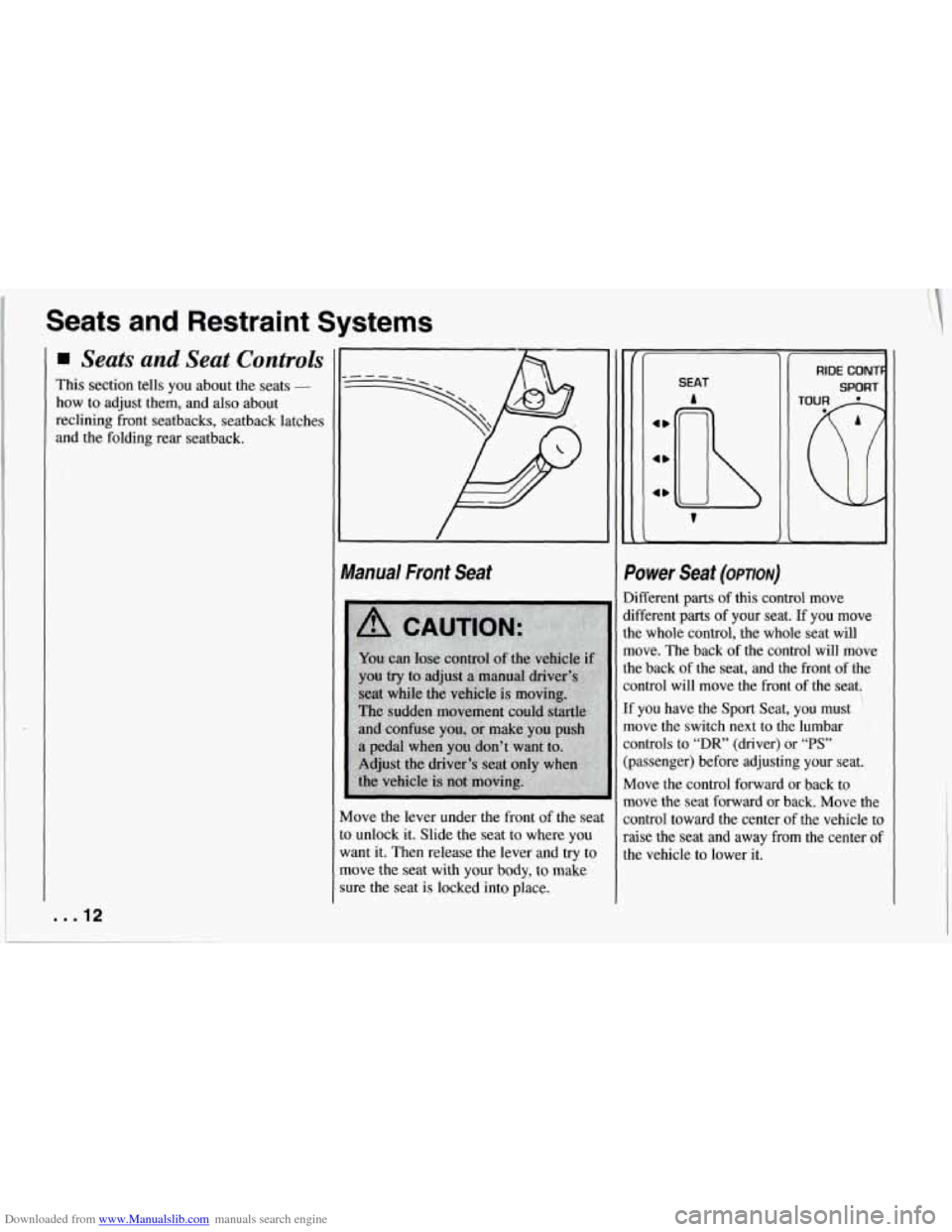
Downloaded from www.Manualslib.com manuals search engine Seats and Restraint Systems
Seats and Seat Controls
This section tells you about the seats -
how to adjust them, and also about
reclining front seatbacks, seatback latches
and the folding
rear seatback.
k
&
Mc
to
WS
mc
SUI
anual Front Seat
4B
4b
4b
SEAT
A
RIDE CONTF
SPORT
Dwer Seat (OPTION)
fferent parts of this control move
Yerent
parts of your seat. If you move
5 whole control, the whole seat will
we. The back of the control will move
: back of the seat, and the front of the
ntrol will move the front of the seat.
you have the
Sport Seat, you must
lve the switch next to the lumbar
ntrols to
“DR’ (driver) or “PS”
assenger) before adjusting your seat.
ove the control forward or back to
we the seat forward or back. Move the
ntrol toward the center of the vehicle to
Ise the seat and away from the center
of
: vehicle to lower it.
L
Page 26 of 274
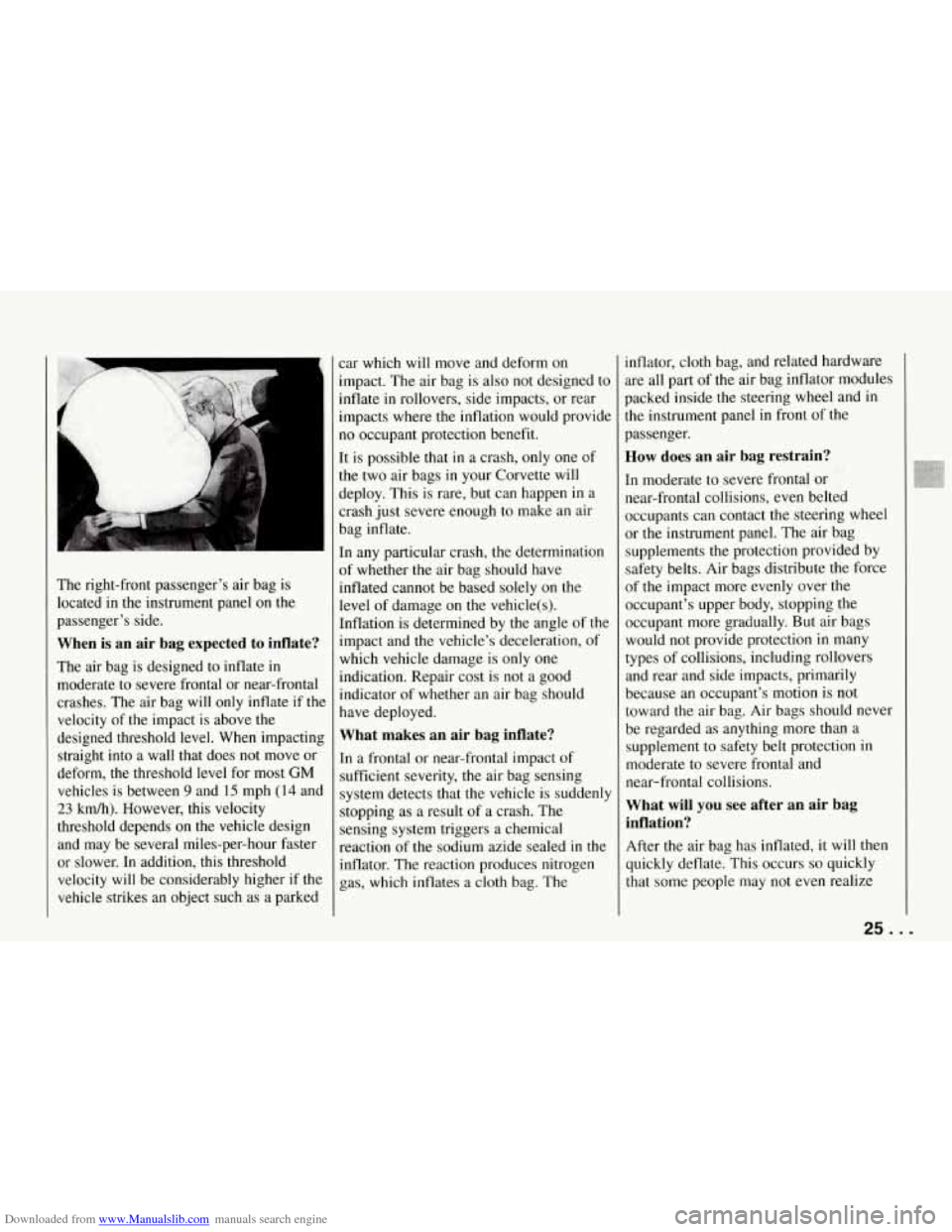
Downloaded from www.Manualslib.com manuals search engine The right-front passenger’s air bag is
located in the instrument panel on the
passenger’s side.
When is an air bag expected to inflate?
The air bag is designed to inflate in
moderate to severe frontal or near-frontal
crashes. The air bag will only inflate
if the
velocity of
the impact is above the
designed threshold level. When impacting straight into a wall that does not move or
deform, the threshold level for most
GM
vehicles is between 9 and 15 mph (14 and
23 kdh). However, this velocity
threshold depends on the vehicle design
and may be several miles-per-hour faster
or slower. In addition,
this threshold
velocity
will be considerably higher if the
vehicle strikes an object such as a parked car which will move and deform
on
impact. The air bag is also not designed to
inflate in rollovers, side impacts, or rear
impacts where the inflation would provide
no occupant protection benefit.
It is possible that
in a crash, only one of
the two air bags in your Corvette will
deploy. This is rare, but can happen
in a
crash just severe enough to make an air
bag inflate.
In any particular crash, the determination
of whether the air bag should have
inflated cannot be based solely on the level of damage on the vehicle(s).
Inflation is determined by
the angle of the
impact and the vehicle’s deceleration, of
which vehicle damage is only one
indication. Repair cost is not a good
indicator of whether an air bag should
have deployed.
What makes an air bag inflate?
In a frontal or near-frontal impact of
sufficient severity, the air bag sensing
system detects that
the vehicle is suddenly
stopping as a result
of a crash. The
sensing system triggers a chemical
reaction of
the sodium azide sealed in the
inflator. The reaction produces nitrogen
gas, which inflates a cloth bag. The inflator,
cloth bag, and related hardware
are all part of the air bag inflator modules
packed inside the steering wheel and
in
the instrument panel in front of the
passenger.
How does an air bag restrain?
In moderate to severe frontal or
near-frontal collisions, even belted
occupants can contact the steering
wheel
or the instrument panel. The air bag
supplements the protection provided by
safety belts.
Air bags distribute the force
of the impact more evenly over the
occupant’s upper body, stopping the
occupant more gradually. But air bags
would not provide protection in many
types of collisions, including rollovers
and rear and side impacts, primarily
because an occupant’s motion is not
toward the air bag. Air bags should never
be regarded as anything more than a
supplement to safety belt protection in
moderate to severe frontal and
near-frontal collisions.
What will you see after an air bag
inflation?
After the air bag has inflated, it will then
quickly deflate. This occurs
so quickly
that some people
may not even realize
25 . ,
Page 33 of 274
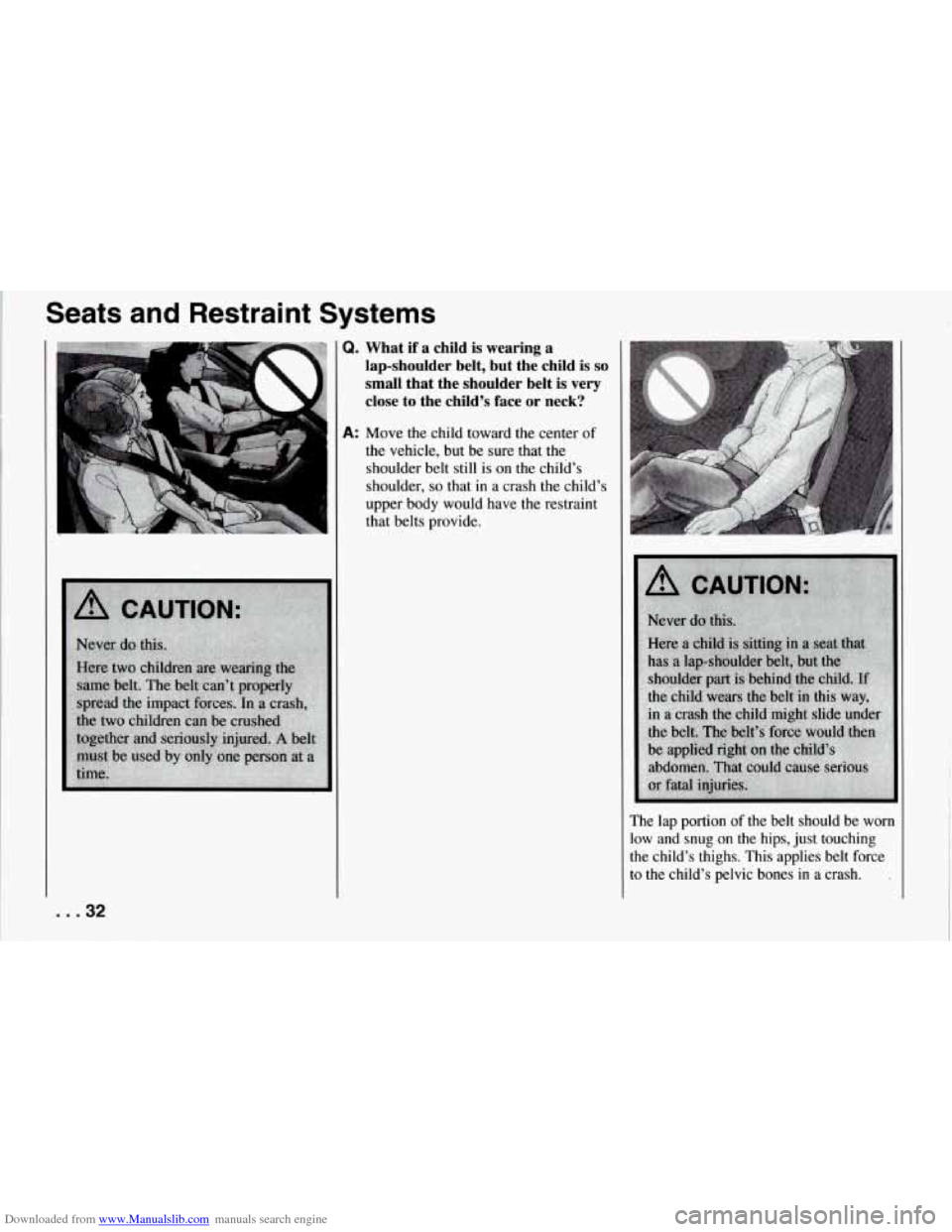
Downloaded from www.Manualslib.com manuals search engine Seats and Restraint Systems
Q. What if a child is wearing a
lap-shoulder belt, but the child
is so
small that the shoulder belt is very
close to the child’s face
or neck?
A: Move the child toward the center of
the vehicle, but be sure that the
shoulder belt still
is on the child’s
shoulder,
so that in a crash the child’s
upper body would have the restraint
that belts provide.
The lap portion of the belt should be worn
low and snug on the hips, just touching
the child’s thighs. This applies belt force
to the child’s pelvic bones in a crash.
.
... 32
Page 39 of 274
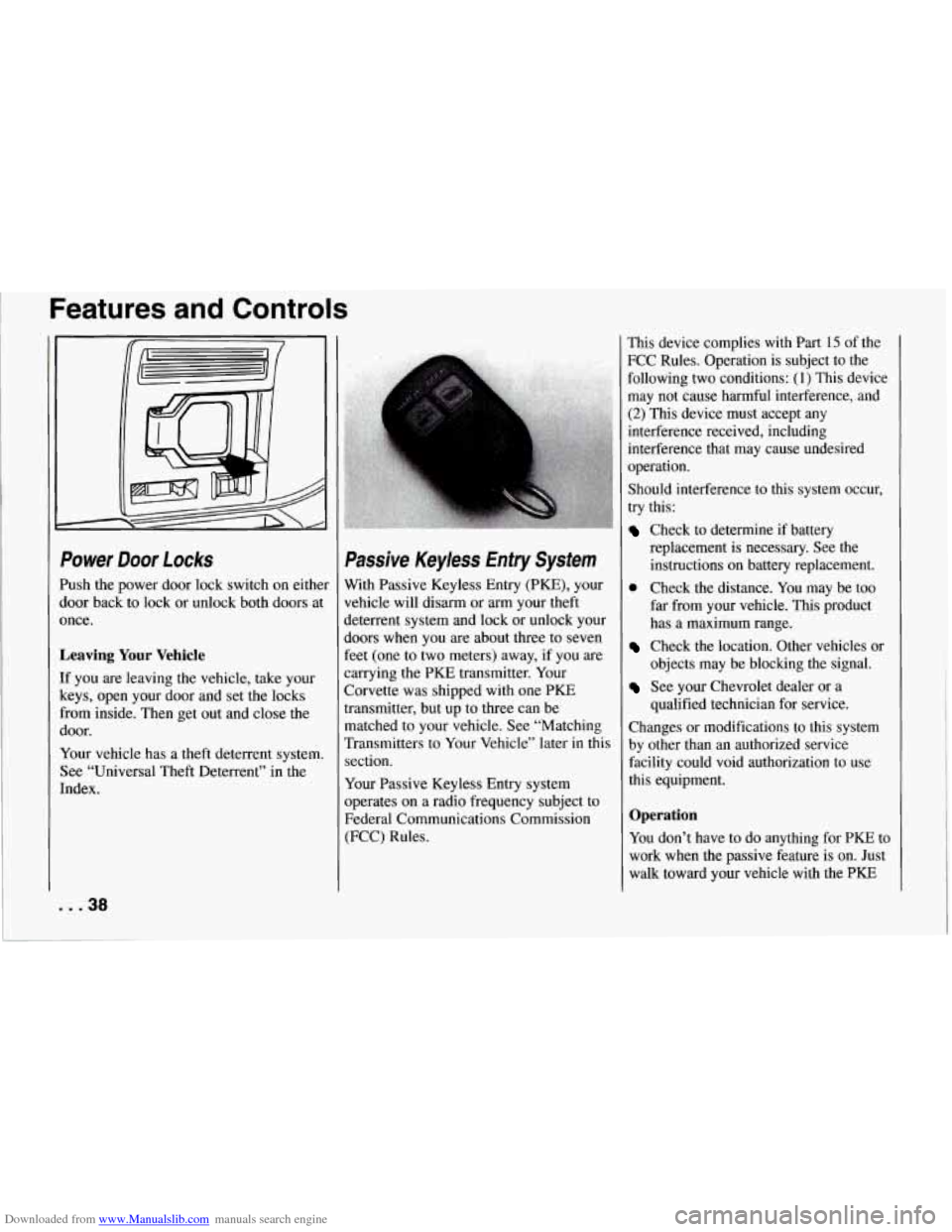
Downloaded from www.Manualslib.com manuals search engine Features and Controls
Power Door Locks
Push the power door lock switch on either
door back to lock or unlock both doors at
once.
Leaving Your Vehicle
If you are leaving the vehicle, take your
keys, open your door and set the locks
from inside. Then get out and close the
door.
Your vehicle has a theft deterrent system.
See “Universal Theft Deterrent” in the
Index.
Passive Keyless Entry System
With Passive Keyless Entry (PJSE), your
vehicle will disarm or
arm your theft
deterrent system and lock or unlock your
doors when you are about three to seven
feet (one to two meters) away, if you are
carrying the PKE transmitter. Your
Corvette was shipped with one
PKE
transmitter, but up to three can be
matched to your vehicle. See “Matching
Transmitters to Your Vehicle” later in this
section.
Your Passive Keyless Entry system
operates on a radio frequency subject to
Federal Communications Commission
(FCC) Rules. This
device complies with
Part 15 of the
FCC Rules. Operation is subject to the
following two conditions: (1) This device
may not cause harmful interference, and
(2) This device must accept any
interference received, including
interference that may cause undesired
operation.
Should interference to this system occur,
try this:
Check to determine if battery
replacement is necessary. See the
instructions on battery replacement.
Check the distance. You may be too
far from your vehicle. This product
has
a maximum range.
Check the location. Other vehicles or
objects may be blocking the signal.
See your Chevrolet dealer or a
qualified technician for service.
Changes or modifications to this system
by other than an authorized service
facility could void authorization to use this equipment.
Operation
You don’t have to do anything for PKE to
work when the passive feature
is on. Just
walk toward your vehicle with the PKE
... 38
Page 47 of 274
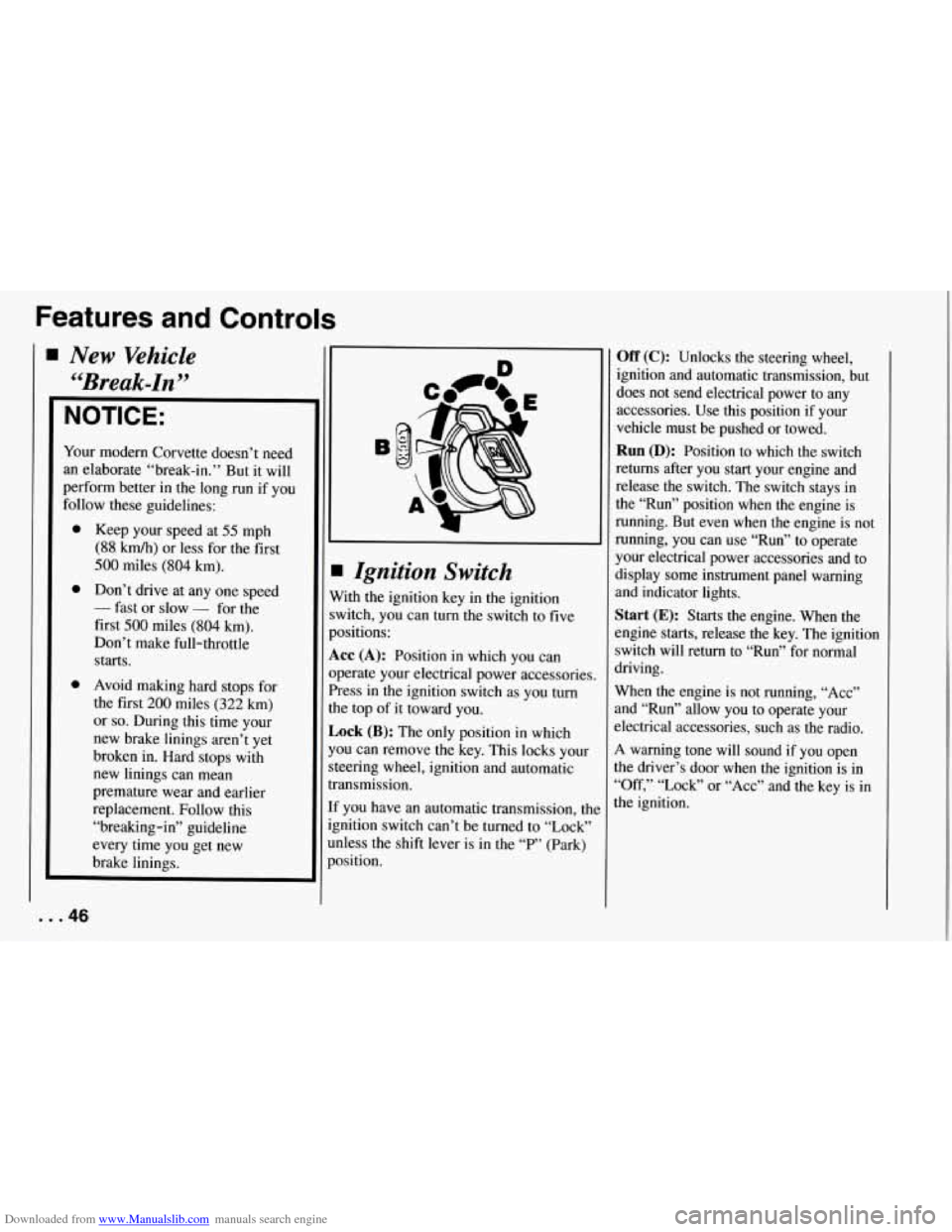
Downloaded from www.Manualslib.com manuals search engine Features and Controls
NOTICE:
Your modern Corvette doesn’t need
an elaborate “break-in.” But it will
perform better in the long run if you
follow these guidelines:
0 Keep your speed at 55 mph
(88 km/h) or less for the first
500 miles (804 km).
Don’t drive at any one speed
- fast or slow - for the
fist
500 miles (804 km).
Don’t make full-throttle
starts.
Avoid malung hard stops for
the first
200 miles (322 km)
or so. During this time your
new brake linings
aren’t yet
broken in.
Hard stops with
new linings can mean
premature wear and earlier
replacement. Follow this
“breaking-in” guideline
every time you get new
brake linings.
I
Ignition Switch
With the ignition key in the ignition
switch, you can turn the switch to five
positions:
Acc (A): Position in which you can
operate your electrical power accessories.
Press in the ignition switch as you turn
the top of it toward you.
Lock (B): The only position in which
you can remove the key. This locks your
steering wheel, ignition and automatic
transmission.
If you have an automatic transmission, tht
ignition switch can’t be turned to “Lock”
unless the shift lever
is in the “P” (Park)
position.
... 46
Off (C): Unlocks the steering wheel,
ignition and automatic transmission, but
does not send electrical power to any
accessories. Use
this position if your
vehicle must be pushed
or towed.
Run (D): Position to which the switch
returns after you start your engine and
release the switch. The switch stays in
the “Run” position when the engine is
running. But even when the engine is not
running, you can use “Run” to operate
your electrical power accessories and to
display some instrument panel warning
and indicator lights.
Start (E): Starts the engine. When the
engine
starts, release the key. The ignition
switch will return to “Run” for normal
driving.
When the engine is not running, “Acc”
and “Run” allow you to operate your
slectrical accessories, such as the radio.
A warning tone will sound if you open
the driver’s door when the ignition is in
“Off,’’ “Lock” or “Acc” and the key is in
the ignition.
Page 49 of 274
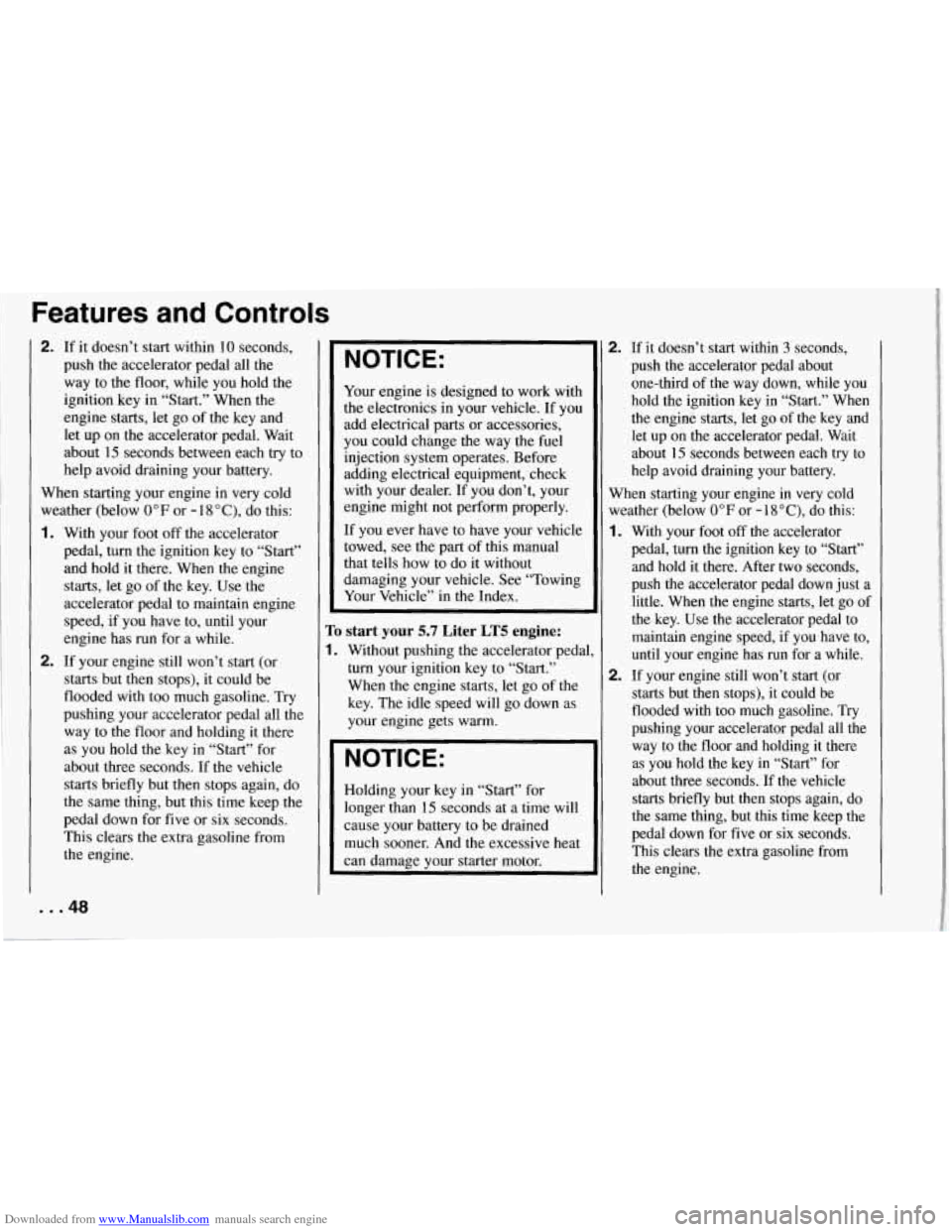
Downloaded from www.Manualslib.com manuals search engine Features and Controls
2. If it doesn’t start within 10 seconds,
push the accelerator pedal all the
way to the floor, while you hold the
ignition key in “Start.” When the
engine starts, let go of the key and
let up on the accelerator pedal. Wait
about
15 seconds between each try to
help avoid draining your battery.
When starting your engine in very cold
weather (below
0°F or - 18 “C), do this:
1.
2.
With your foot off the accelerator
pedal, turn the ignition key to “Start”
and hold it there. When the engine
starts, let go of the key. Use the
accelerator pedal to maintain engine
speed, if you have to, until your
engine has run for a while.
If your engine still won’t start (or
starts but then stops), it could be
flooded with too much gasoline. Try
pushing your accelerator pedal all the
way to
the floor and holding it there
as you hold the key in “Start” for
about three seconds. If
the vehicle
starts briefly but then stops again, do
the same thing, but this time keep the
pedal down for five or six seconds.
This clears the extra gasoline from
the engine.
NOTICE:
Your engine is designed to work with
the electronics in your vehicle. If you
add electrical parts or accessories,
you could chimge the way the fuel
injection system operates. Before
adding electrical equipment, check
with your dealer. If you don’t, your
engine might not perform properly.
If you ever have to have your vehicle
towed, see
the part of this manual
that tells how to do it without
damaging your vehicle. See “Towing
Your Vehicle”
in the Index.
Ib start your 5.7 Liter LT5 engine:
1. Without pushing the accelerator pedal
turn your ignition key to “Start.”
When the engine starts, let go of
the
key. The idle speed will go down as
your engine gets warm.
NOTICE:
Holding your key in “Start” for
longer than
15 seconds at a time will
cause your battery to be drained
much sooner. And the excessive heat
can damage your starter motor.
2. If it doesn’t start within 3 seconds,
push the accelerator pedal about one-third of the way down, while you
hold the ignition key
in “Start.” When
the engine starts, let go of the key and
let up on the accelerator pedal. Wait
about
15 seconds between each try to
help avoid draining your battery.
When starting your engine in very cold weather (below
0°F or -18”C), do this:
1.
2.
With your foot off the accelerator
pedal,
turn the ignition key to “Start”
and hold it there. After two seconds,
push the accelerator pedal down just a
little. When the engine starts, let go of
the key. Use the accelerator pedal to
maintain engine speed, if you have to,
until your engine has
run for a while.
If your engine still won’t start (or
starts but then stops), it could be
flooded with too much gasoline. Try
pushing your accelerator pedal all the way to the floor and holding it there
as you hold the key in “Start” for
about three seconds. If the vehicle
starts briefly but then stops again, do
the same thing, but this time keep
the
pedal down for five or six seconds.
This clears the extra gasoline from
the engine.
... 48
Page 50 of 274
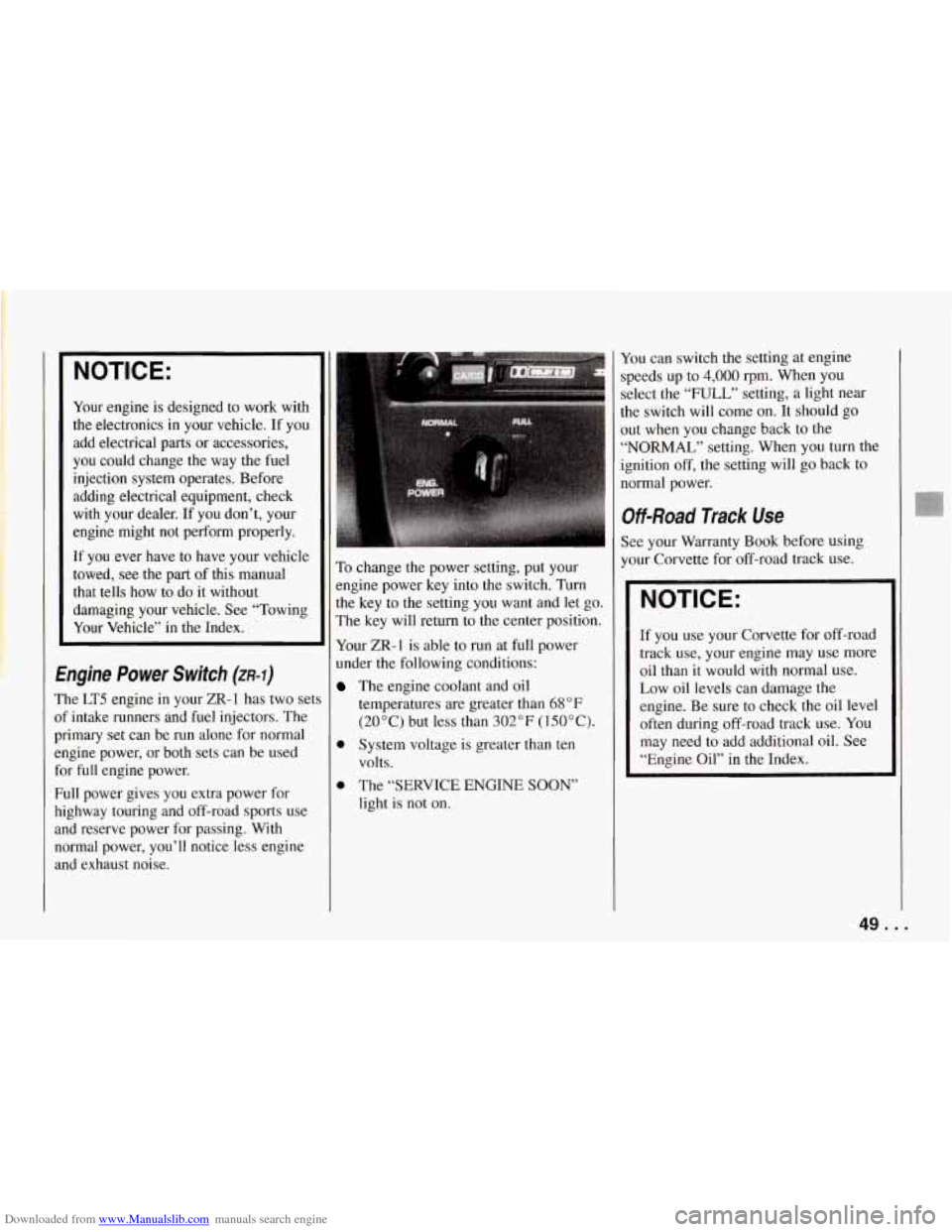
Downloaded from www.Manualslib.com manuals search engine I NOTICE:
Your engine is designed to work with
the electronics in your vehicle. If you
add electrical parts or accessories,
you could change the way the fuel
injection system operates. Before
adding electrical equipment, check
with your dealer. If you don’t, your
engine might not perform properly.
If you ever have to have your vehicle
towed, see the part
of this manual
that tells how to do it without
damaging your vehicle. See “Towing
Your Vehicle” in the Index.
Engine Power Switch (ZR-I)
The LT5 engine in your ZR-1 has two sets
of intake runners and fuel injectors. The
primary set can be run alone for normal
engine power, or both sets can be used
for
full engine power.
Full power gives you extra power for
highway touring and off-road sports use
and reserve power for passing. With
normal power, you’ll notice less engine
and exhaust noise. To
change the power setting, put your
engine power key into the switch. Turn
the key to the setting you want and let
go
The key will return to the center position.
Your ZR-1 is able to run at full power
under the following conditions:
The engine coolant and oil
temperatures are greater than
68 OF
(20°C) but less than 302°F (150°C).
e System voltage is greater than ten
e The “SERVICE ENGINE SOON’
volts.
light is not on.
You can switch the setting at engine
speeds up to
4,000 rpm. When you
select the
“FULL” setting, a light near
[he switch will come on. It should go
>ut when you change back to the
“NORMAL” setting. When you turn the
ignition
off, the setting will go back to
normal power.
Off-Road Track Use
See your Warranty Book before using
your Corvette for off-road track use.
NOTICE:
If you use your Corvette for off-road
track use, your engine may use more
oil than it would with normal use.
Low oil levels can damage the
engine. Be sure to check the oil level
often during off-road track use.
You
may need to add additional oil. See
“Engine Oil” in the Index.
49 ...
Page 53 of 274
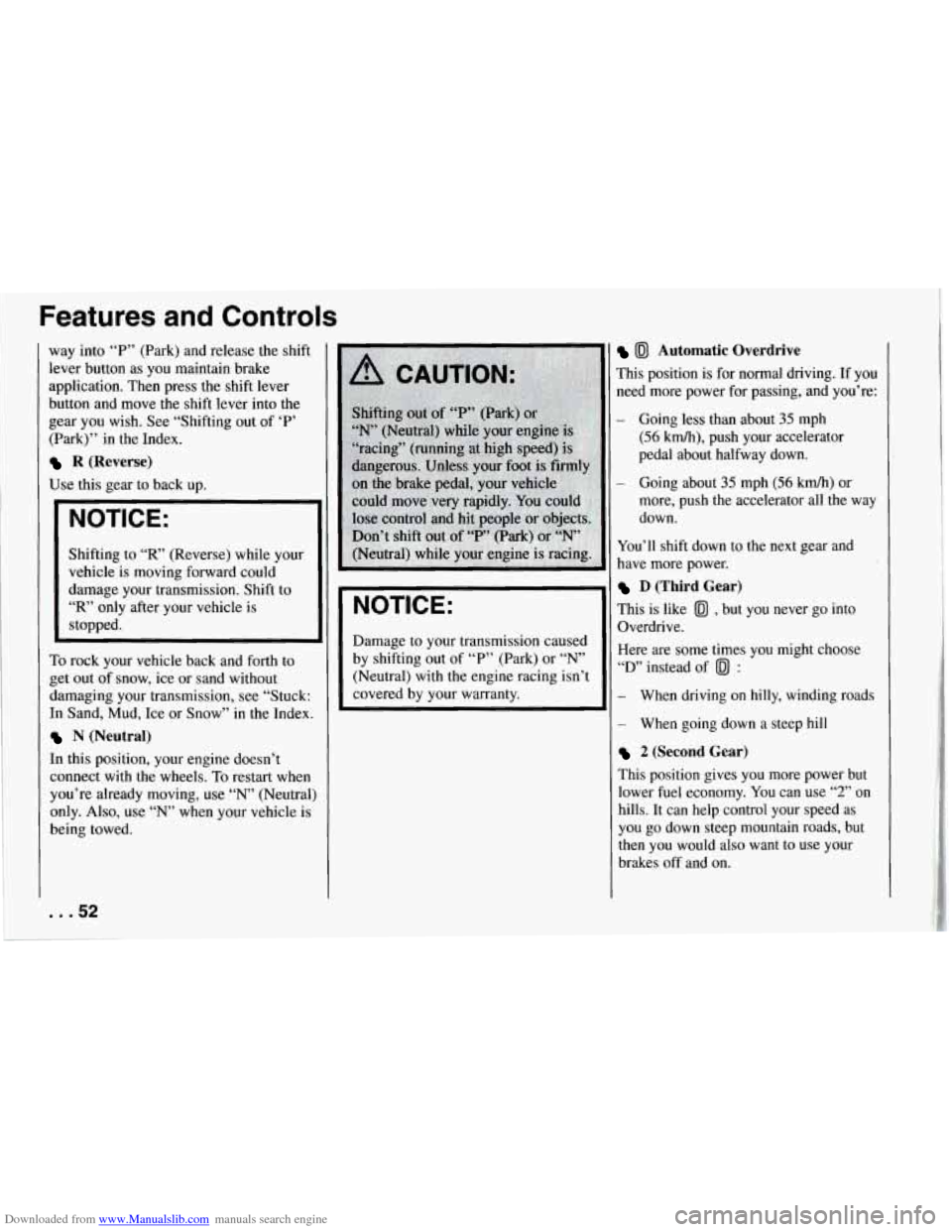
Downloaded from www.Manualslib.com manuals search engine Features and Controls
way into “P” (Park) and release the shift
lever button as you maintain brake
application. Then press the shift lever
button and move the shift lever into the
gear
you wish. See “Shifting out of ‘P’
(Park)” in the Index.
R (Reverse)
Use this gear to back up.
NOTICE:
dangerous. Unless your foot is
on the brake pedal, your
could move very rapidly.
lose control and hit
Don’t shift
out of
Shifting to “R’ (Reverse) while your
vehicle is moving forward could
damage your transmission. Shift to
“R’ only after your vehicle is
stopped.
To rock your vehicle back and forth to
get out of snow, ice or sand without
damaging your transmission, see “Stuck:
In Sand, Mud, Ice or Snow” in the Index.
N (Neutral)
In this position, your engine doesn’t
connect with the wheels. To restart when
you’re already moving, use
“N’ (Neutral:
only. Also, use
“N’ when your vehicle is
being towed.
... 52
NOTICE:
I
Damage to your transmission caused
by shifting out of “P” IPark) or
“N’
(Neutral) with the engine racing isn’t
covered by your warranty.
0 Automatic Overdrive
This position is for normal driving. If you
need more power for passing, and you’re:
- Going less than about 35 mph
(56 kmh), push your accelerator
pedal about halfway down.
- Going about 35 mph (56 km/h) or
more, push the accelerator all the way
down.
You’ll shift down to the next gear and
have more power.
D (Third Gear)
This is like 0 , but you never go into
Overdrive.
Here are some times
you might choose
“D’ instead of 0 :
- When driving on hilly, winding roads
- When going down a steep hill
2 (Second Gear)
This position gives you more power but
lower
fuel economy. You can use “2” on
hills. It can help control your speed as
you
go down steep mountain roads, but
then you would also want to use your
brakes
off and on.
Page 56 of 274
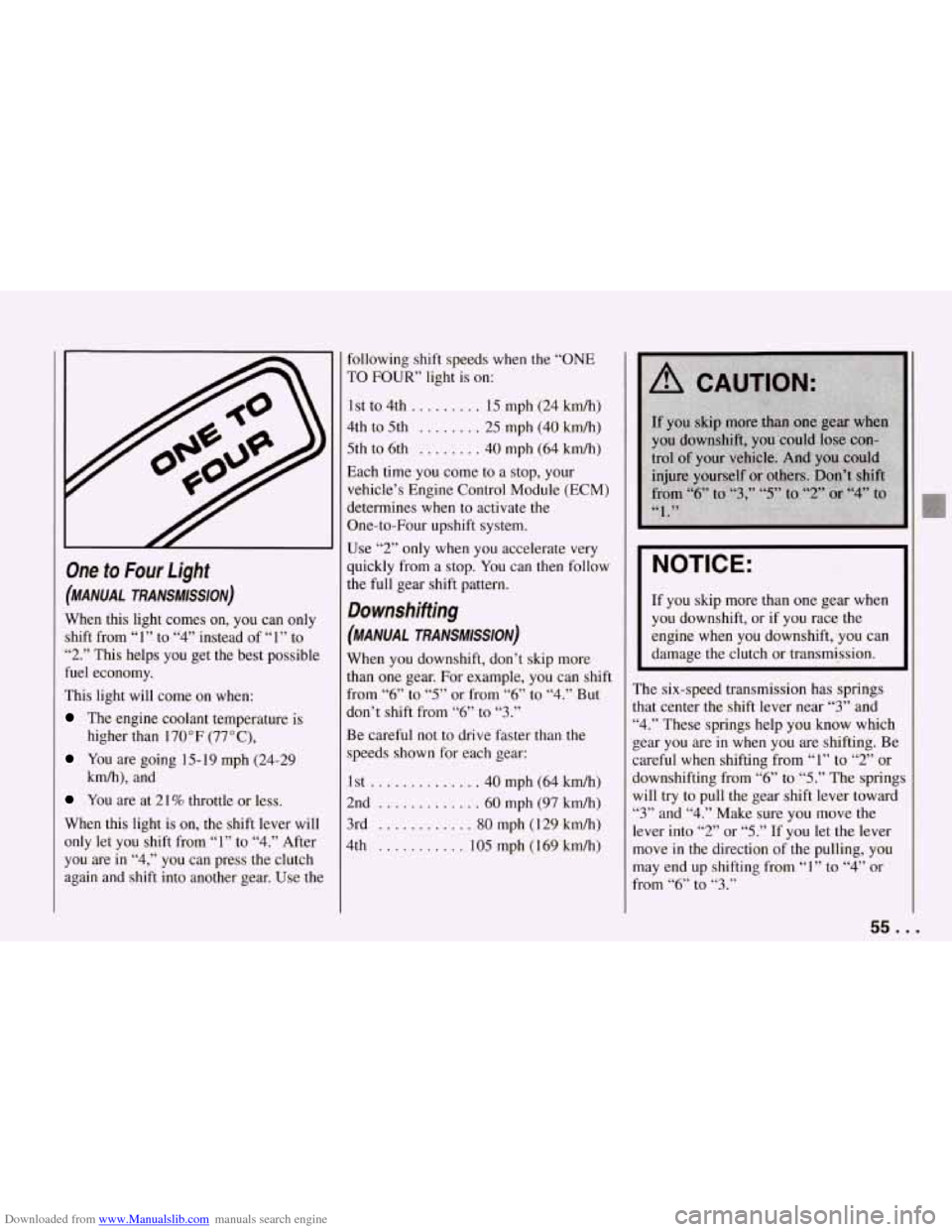
Downloaded from www.Manualslib.com manuals search engine One to Four Light
(MANUAL TRANSMISSION)
When this light comes on, you can only
shift from “1” to
“4” instead of “1” to
“2.” This helps you get the best possible
fuel economy.
This light will come on when:
The engine coolant temperature is
higher than 170°F (77”C),
You are going 15- 19 mph (24-29
kmh), and
You are at 21% throttle or less.
When this light is on, the shift lever will
only let you shift from “1” to
“4.” After
you are in “4,” you can press the clutch
again and shift into another gear. Use the following shift speeds
when the “ONE
TO FOUR’ light is on:
1st to 4th..
....... 15 mph (24 km/h)
4th to 5th ........ 25 mph (40 kmh)
5th to 6th ........ 40 mph (64 km/h)
Each time you come to a stop, your
vehicle’s Engine Control Module (ECM)
determines when to activate
the
One-to-Four upshift system.
Use
“2” only when you accelerate very
quickly from a stop. You can then follow
the full gear shift pattern.
Downshifting
(MANUAL TRANSMISSION)
When you downshift, don’t skip more
than one gear. For example, you can shift
from
“6” to “5” or from “6” to “4.” But
don’t shift from
“6” to “3.”
Be careful not to drive faster than the
speeds shown for each gear:
1st
.............. 40 mph (64 kmh)
2nd
............. 60 mph (97 kmh)
3rd
............ 80 mph (1 29 kmh)
4th ........... 105 mph (169 kmh)
I NOTICE:
If you skip more than one gear when
you downshift, or if you race the
engine when you downshift, you can
damage the clutch or transmission.
~~
The six-speed transmission has springs
that center the shift lever near
“3” and
“4.” These springs help you know which
gear you are in when you are shifting. Be
careful
when shifting from “1” to “2” or
downshifting from “6” to
“5.” The spring;
will try to pull the gear shift lever toward
“3” and “4.” Make sure you move the
lever into
“2” or “5.” If you let the lever
move
in the direction of the pulling, you
may end up shifting from
“1” to “4” or
from
“6” to “3.”
55. .
Page 57 of 274
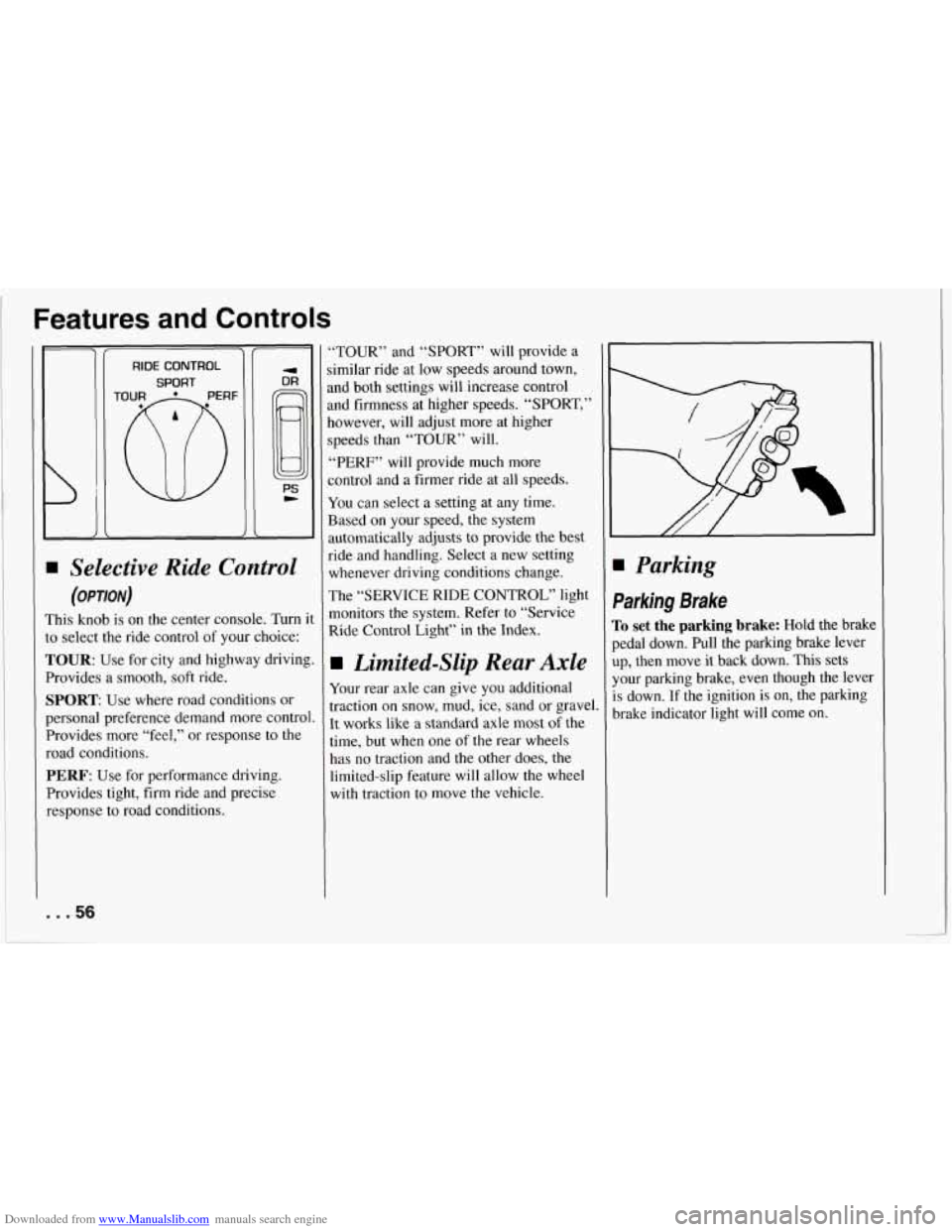
Downloaded from www.Manualslib.com manuals search engine Features and Controls
RIDE CONTROL
SPORT
To@F
fl
-
PS c
Selective Ride Control
(OPTION)
This knob is on the center console. Turn i
to select the ride control of your choice:
TOUR: Use for city and highway driving
Provides a smooth, soft ride.
SPORT: Use where road conditions or
personal preference demand more control
Provides more “feel,” or response to the
road conditions.
PERF: Use for performance driving.
Provides tight, firm ride and precise
response to road conditions. ‘TOUR” and “SPORT” will
provide a
imilar ride at low speeds around town,
md both settings will increase control
tnd firmness at higher speeds. “SPORT,”
lowever, will adjust more at ‘higher
;peeds than “TOUR” will.
,‘PERF” will provide much more
Zontrol and a firmer ride at all speeds.
You can select a setting at any time.
Based on your speed,
the system
wtomatically adjusts to provide the best
aide and handling. Select a new setting
whenever driving conditions change.
The “SERVICE
RIDE CONTROL” light
monitors the system. Refer to “Service
Ride Control Light” in the Index.
Limited-Slip Rear Axle
Your rear axle can give you additional
traction on snow, mud, ice, sand or gravel.
It works like a standard axle most
of the
time, but when one of the rear wheels
has no traction and the other does,
the
limited-slip feature will allow the wheel
with traction to move the vehicle.
Parking
Parking Brake
To set the parking brake: Hold the brak
pedal down. Pull the parking brake lever
up, then move it back down. This sets
your parking brake, even though the leve
is down. If the ignition is on, the parking
brake indicator light will come on.
... 56